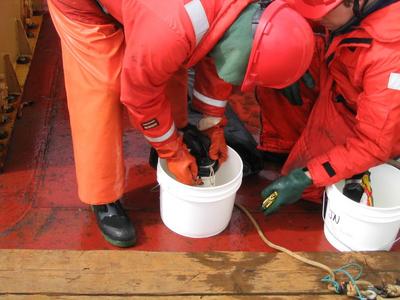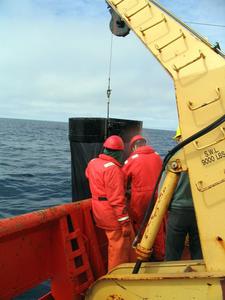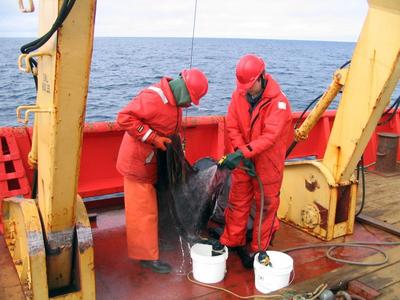
|
|
14 July, 2004
Rather than use this journal to tell you about one specific science project,
I'll fill you in on the day in general and catch you up with a couple of
pictures I missed before. The day started for me at 5:30 AM when we were
scheduled to get water from the CTD cast. We actually got "on station" (the
correct latitude and longitude) around 6:15 and started to collect water
shortly after the CTD was back on deck. As Bon van Hardenberg, chief
scientist, said, "It's time to milk the sea cow." Since I'm from Vermont,
that analogy made perfect sense! While Ari and Rebecca collected water for
their work, Alicia and I helped Peter Lee collect nearly 36 bottles of
water. Each bottle must be double rinsed with sea water before the water
can be collected and stored. Having three pairs of (gloved) hands makes the
work go much faster. Peter's biggest problem, however, is the fact that the
person who was supposed to come with him was unable, at the last minute, to
join the cruise. Since Peter must filter all the water from the CTD bottles
AND collect and filter water once each hour while the ship is underway, he
essentially has a 24 hour/day job. Because he needs at least some sleep,
each of us tries to help out with the underway sampling. I was able to do
the morning and early afternoon samples for him and I got a much better
appreciation for the work involved. Although it's not difficult, it must be
done with care and it must be done every hour that the ship is moving!
In the early afternoon, we stopped to do bongo nets and then to deploy a
mooring. Problems with the ship's boom delayed the process for much of the
afternoon. Once the first mooring went in, the ship moved a short distance,
and Sarah and Bill (I'll fill you in when I have had a chance to speak with
them about their work) and members of the crew deployed a second mooring. A
CTD cast was set for immediately after the moorings, but it had to go down
twice due to problems with the first cast. We just finished collecting
water from the CTD, and it is 7:45 PM. All of today's work got done; it
just took a bit longer than was planned.
I'll include mooring pictures on the day I describe the process. For today,
I've included pictures of the bongo nets and a good picture of the CTD
bottle rosette. Remember that the bongo nets are dropped down and then
brought up vertically to capture the zooplankton in the water.
--

Once all the zooplankton is washed from the nets, these bottles are dumped out. --

The CTD bottle rosette is ready to go into the water. (Photo by Bon van Hardenberg) --

The bongo nets being brought back on board. --

Once the nets come on board, they must be washed down in order to get all the zooplankton into the collecting bottles. --

Two bongo nets are used each time in order to get replicate samples. --
Contact the TEA in the field at
.
If you cannot connect through your browser, copy the
TEA's e-mail address in the "To:" line of
your favorite e-mail package.
|
